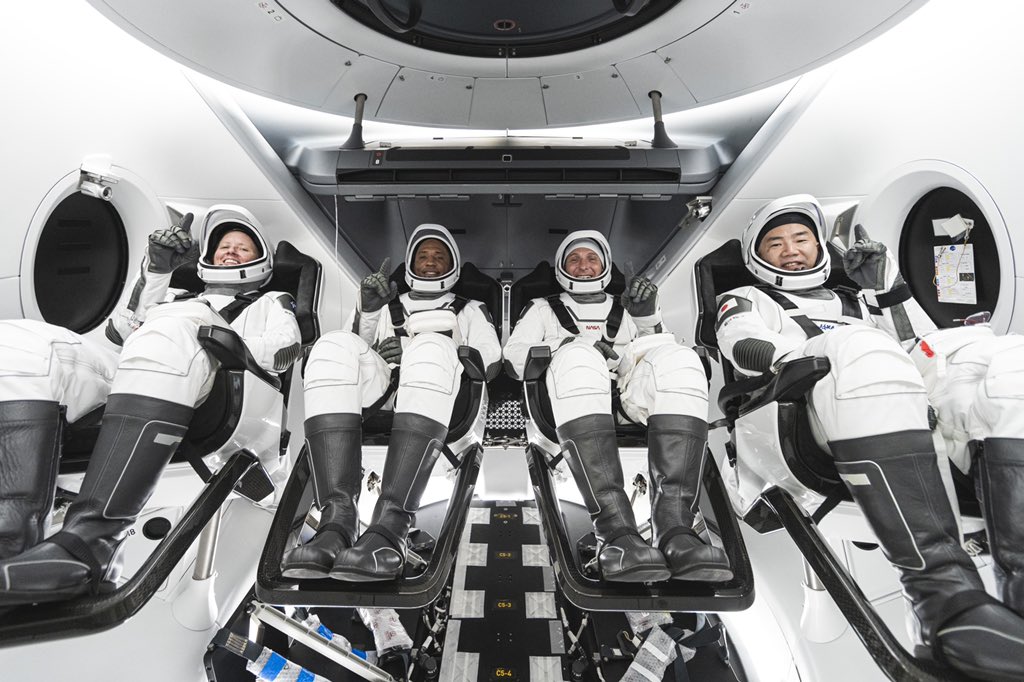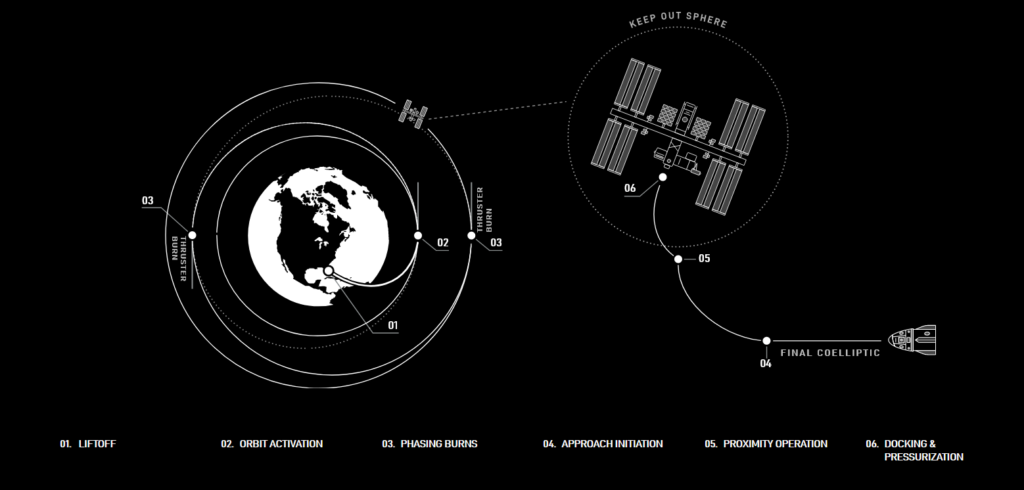A SpaceX Crew Dragon is going to carry four humans to space station as part of the first operational mission leaving US shores in almost a decade.

Despite a global pandemic, a record hurricane season and having to swap out problematic rocket engines, NASA and SpaceX remain determined to get the historic Crew-1 mission off the ground from Florida on Monday. The flight of four astronauts to the International Space Station in a Crew Dragon capsule atop a Falcon 9 rocket follows the success of the Demo-2 mission and its historic splashdown and will set a few key spaceflight milestones.
Here is everything you need to know about the Crew-1 mission.
Why was the launch pushed back?
The targeted launch date for Crew-1 was pushed back from late October after NASA and SpaceX noticed some unexpected behavior from a few Falcon 9 engines that were set to be used for an unrelated mission to launch a military GPS satellite. That mission was scrubbed with just two seconds left on the countdown and an investigation later revealed a stray bit of lacquer had clogged a tiny relief valve line. The clog caused two of the rocket’s engines to try and fire early, potentially damaging the engines had liftoff not been automatically aborted.
SpaceX found that engines in the rocket to be used for Crew-1 had the “same tendencies.” Launch date was moved to November, the engines were swapped out and now NASA and SpaceX are both satisfied that it’s go time.
Read: SPACEX BEATS BOEING? HOW SPACEX WON SENDING ASTRONAUTS TO SPACE
Why is Crew-1 a big deal?
Crew-1 is part of the culmination of NASA’s Commercial Crew program that’s been years in the works. For decades, NASA has typically developed its own rockets and spacecraft internally with the help of contractors, but the Commercial Crew program works more like chartering a flight. Companies like SpaceX and Boeing have vehicles designed to be used by other customers, and NASA can hitch a ride on them.
It’s also a huge step in bringing spaceflight back to US soil. From the end of the Space Shuttle program in 2011 up until the Demo-2 mission that sent two NASA astronauts to the ISS aboard a Crew Dragon earlier this year, NASA has relied on Russian Soyuz spacecraft to shuttle its astronauts to orbit.
Demo-2 was considered a successful demonstration of Crew Dragon and NASA looks at Crew-1 as the first official crew rotation mission from US shores since the retirement of the Shuttle. “It’s exciting, especially with Crew-1 being the first time we’ve ever put four people on a space capsule ever, as humans, like that’s pretty cool,” explained NASA’s Anthony Vareha, the lead flight director for the mission. “It’s also the longest mission of a crewed US capsule ever.”
Who is flying in the Crew Dragon?
The crew supporting this mission is composed of three NASA astronauts and one JAXA astronaut:
- Commander: NASA astronaut Mike Hopkins
- Pilot: NASA astronaut Victor Glover
- Mission Specialist: NASA astronaut Shannon Walker
- Mission Specialist: JAXA astronaut Soichi Noguchi
How long is the trip?
The members of Crew-1 are embarking on a six-month science mission, which is exciting for people involved in the orbital and space science world because four crew members making the trip amounts to more hands available on the station to do more experiments in microgravity.
“It’s going to be exciting to be able to see how much work we can get done while we’re there,” Hopkins said Monday.
But first, of course, the astronauts will have to get there. The actual trip to the ISS takes just about eight-and-a-half hours from launch Sunday morning(6:19 AM IST) to docking with the station early Sunday afternoon(2:50 PM IST).
Crew-1 Mission Profile
After liftoff, Falcon 9’s first stage will propel the astronauts for 2 minutes and 30 seconds to an altitude of around 75 km (~47 miles). After stage separation, Falcon 9’s second stage takes over for the second part of the flight. Approximately 6 minutes and 7 seconds after second stage engine ignition the second stage engine will shut down (SECO) and the astronauts will be in orbit. 3 minutes and 19 seconds after SECO, Crew Dragon will separate from the second stage and open up its nosecone in order to expose the forward facing Draco thrusters.
Read: WHY DOES THE SPACEX DRONE SHIP CAMERA CUT OUT OFF UPON LANDING
Once the Draco thrusters are exposed, Crew Dragon will perform a number of phasing burns to align its orbit with the ISS’ one. After the phasing burns, Crew Dragon will slowly approach the ISS and with the start of proximity operations it will enter the ISS’ Keep Out Sphere. Last but not least, after around 8 hours and 30 minutes, C207 Resilience will autonomously dock to the same docking port as Bob and Doug’s C206 Endeavour.

Crew-1 Mission Timeline
COUNTDOWN AND LAUNCH
Hr/Min/Sec Event
– 00:45:00 SpaceX Launch Director verifies go for propellant load
– 00:42:00 Crew access arm retracts
– 00:37:00 Dragon launch escape system is armed
– 00:35:00 RP-1 loading begins
– 00:35:00 1st stage LOX loading begins
– 00:16:00 2nd stage LOX loading begins
– 00:07:00 Falcon 9 begins engine chill prior to launch
– 00:05:00 Dragon transitions to internal power
– 00:01:00 Command flight computer to begin final prelaunch checks
– 00:01:00 Propellant tank pressurization to flight pressure begins
– 00:00:45 SpaceX Launch Director verifies go for launch
– 00:00:03 Engine controller commands engine ignition sequence to start
– 00:00:00 Falcon 9 Liftoff
LAUNCH, LANDING, AND DRAGON 2 DEPLOYMENT
Hr/Min/Sec Event
00:00:58 Max Q (moment of peak mechanical stress on the rocket)
00:02:30 1st stage main engine cutoff (MECO)
00:02:34 1st and 2nd stages separate
00:02:36 2nd stage engine starts
00:07:12 1st stage entry burn
00:08:43 2nd stage engine cutoff (SECO-1)
00:08:45 1st stage entry burn
00:09:09 1st stage landing
00:12:02 Crew Dragon separates from 2nd stage
00:12:48 Dragon nosecone open sequences begins
Read: HOW SPACEX ROCKETS LANDS AUTONOMOUSLY ON A DRONE SHIP AND LAND
How do I watch?
NASA and SpaceX will stream the launch, currently set for 5:57 AM IST Monday, Nov. 16(7:27 PM EST Sunday, Nov. 15), from Launch Complex 39A at the Kennedy Space Center.
NASA TV will broadcast the launch and the docking Sunday, and you can watch it all with the link below.
To keep updated on all upcoming launches click here.
Source:
